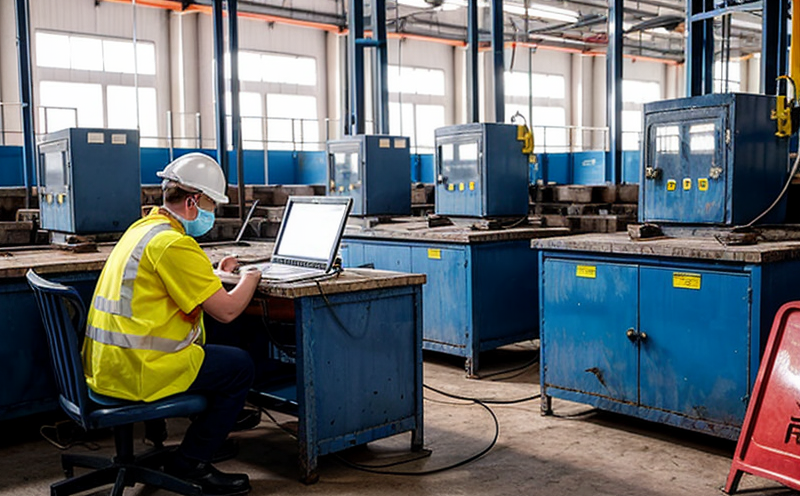ISO 11611 Protective Clothing Testing for Welding Work
The ISO 11611 standard is a cornerstone in occupational health and safety, specifically designed to ensure the protection of workers engaged in welding operations. This testing protocol evaluates the thermal performance of protective clothing under fire exposure conditions, ensuring that the garments provide adequate protection against severe heat stress and potential flash fires encountered during welding processes.
The testing process involves subjecting samples of protective clothing to a controlled flame exposure test. During this test, the material is exposed to flames for 10 seconds, followed by a cooling phase of 5 minutes. The performance of the fabric is then assessed based on its ability to prevent burn injury to the wearer. This assessment includes both radiant heat and convective heat transfer measurements.
The standard also covers other aspects such as flame spread, after-flame duration, and residual smoldering. Compliance with ISO 11611 ensures that workers in welding environments are adequately protected from the risks of severe burns and other thermal hazards. This is particularly critical for quality managers, compliance officers, R&D engineers, and procurement specialists who must ensure that safety protocols align with international best practices.
For instance, in industrial manufacturing settings where welding operations are frequent, ensuring that workers wear protective clothing compliant with ISO 11611 can prevent costly accidents and improve worker morale by enhancing job satisfaction. The testing process is stringent, requiring accurate measurement instruments to ensure reliable data collection. This includes thermocouples for heat measurement and specialized cameras for flame spread analysis.
The results of the test are reported comprehensively, detailing the thermal resistance properties (TRP) of the garment. These reports are crucial for compliance officers as they provide evidence that meets regulatory requirements. For R&D engineers, this testing is a vital step in developing new protective clothing materials and designs that meet or exceed ISO 11611 standards.
- TRP (Thermal Resistance Properties) is directly correlated with the garment's ability to withstand severe heat without causing burn injuries.
- The test ensures compliance with international regulations, thereby enhancing worker safety and reducing risks in welding environments.
Why It Matters
Occupational health and safety testing is paramount in the industrial manufacturing sector. Welding operations present unique challenges due to high temperatures, sparks, and flames, which can lead to severe burns if proper protective measures are not taken. ISO 11611 Protective Clothing Testing for Welding Work is essential because it ensures that workers have garments capable of withstanding these hazards effectively.
- Reduces the risk of burn injuries among employees, thereby decreasing worker absenteeism and associated costs due to medical treatment.
- Enhances overall productivity by ensuring a safer working environment, which can improve worker morale and retention rates.
- Maintains compliance with international standards, such as ISO 11611, which are recognized globally, thereby reducing the risk of non-compliance fines or penalties.
For quality managers, ensuring that all protective clothing meets these rigorous testing criteria is crucial for maintaining a safe and efficient production line. Compliance officers must also ensure ongoing compliance with updated standards to avoid legal issues and maintain a positive public image. R&D engineers benefit from the precise data provided by such tests, which can guide future improvements in protective clothing design.
Eurolab Advantages
At Eurolab, we pride ourselves on providing comprehensive and accurate testing services that meet international standards. Our expertise in ISO 11611 Protective Clothing Testing for Welding Work sets us apart from other laboratories:
- We employ state-of-the-art equipment to ensure precise measurements and reliable results.
- Our team of experienced technicians is trained to handle complex testing protocols, ensuring accurate compliance with ISO 11611 standards.
- We offer quick turnaround times for test results, enabling our clients to make timely decisions regarding protective clothing procurement and improvements.
Moreover, Eurolab’s commitment to quality is reflected in our adherence to strict protocols and continuous calibration of instruments. This ensures that every test conducted at Eurolab meets the highest standards of accuracy and reliability. Our clients can trust us for unbiased testing results that are pivotal for maintaining a safe work environment.
International Acceptance and Recognition
- The ISO 11611 standard is widely recognized in countries like the United States, Europe, and Asia. It has been adopted by organizations such as OSHA (Occupational Safety and Health Administration) in the U.S., which mandates compliance for industries with high-risk environments.
- European Union directives also emphasize the importance of adhering to ISO 11611 standards for protective clothing used in welding operations. This ensures a level playing field across member states, promoting worker safety and reducing industrial hazards.
The global acceptance of ISO 11611 underscores its relevance and effectiveness as an international standard. Compliance with this standard is not only beneficial for workers' health and safety but also essential for maintaining a competitive edge in the global market.





